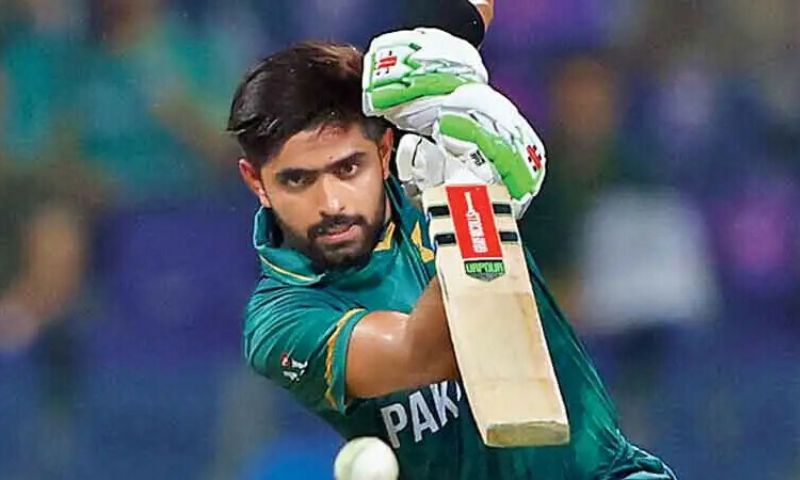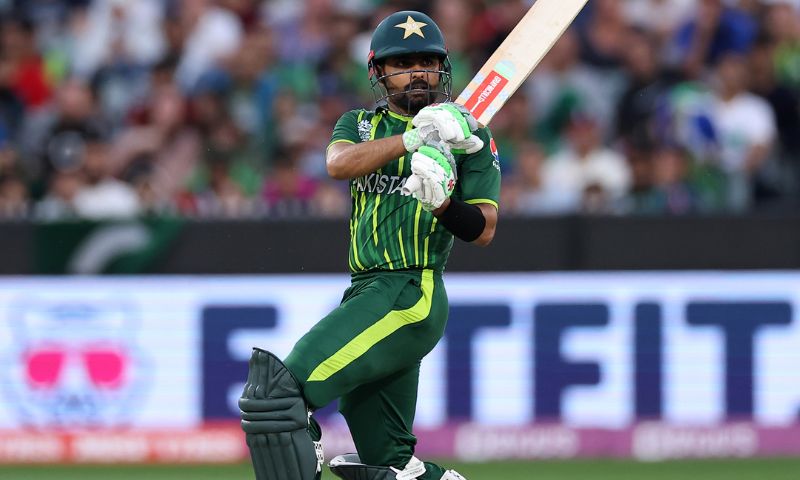“Play straight,” shouted Mama Juna, the coach advising the young boy batting in the nets. Once the boy completed his practice, Mama Juna would embrace him, put his arm on his shoulder, and proudly declared, “You are one of my best students.”
The boy had a dream to play with the best and at the highest level. Days after he scored a hundred in School cricket, the young boy was given a chance to be a ball picker at the Gaddafi Stadium, Lahore. The 13-year-old boy was brimful with joy, confidence, passion, and ecstasy. He was enamoured to see his idols just a few yards away.
Every time the ball would cross the ropes, that young boy would fetch it before others could take the first step. Back home after the match, he would not sleep, for he had seen his two idols of the game — Pakistan’s Mohammad Yousuf and South Africa’s AB de Villiers.
At the same Gadaffi stadium in February 2021, that same boy was leading Pakistan against South Africa. He had made a name for himself as Babar Azam. On May 5, 2023, Babar led Pakistan to a series win over New Zealand — nine years to the day when he was first called up in Pakistan camp.
He showed elation in completing a superb journey that has seen him make a name for himself. “I think my journey has been good; I joined the camp on this very day nine years ago,” reminisced Babar. “There have been ups and down, but the support from my family, PCB, and above all, my teammates has been amazing.”
But it all started as a ball boy collecting the ball and dreaming. Babar frequently recalls those days. Why not? he reckons that as his launchpad. “I wanted to see international players, so I would walk all the way from Gulberg to Gadaffi stadium to watch the match, at times mesmerized by the great players playing a few yards away,” Babar recalled, who now lives in the posh Defense area of Lahore with his three brothers, a sister, and parents.

Babar received huge support from home. His father, Azam Siddiq, noticed his passion and allowed him to attend a coaching club at Muslim Model School. A famous local coach Mohammad Younis, famous as Mama Juna (Old Uncle), who had developed players like Salim Malik and Nasir Jamshed, to name a few, adopted Babar gleefully. The first lesson: “Come first, place nets, and go at the end.” His passion was such that he would walk four to five miles every day, first to the club ground and the last to leave.
Indeed, it was a journey full of ups and downs. Babar was selected for Under-15 in the regional trials, but he managed just 40 runs in three matches. That was nothing notable. But he did not lose heart and did well at the Under-19 level.
From home, not only did he get support but also flak from his father, who was his biggest critic as well as an admirer.
“It’s a blessing for me that my father supported me so much. To be honest, he still scolds me if I don’t play well or get out by playing a rash shot, and I listen to it as a source of blessing. This fear gives me tension that if I don’t perform well, I’ll be scolded by my father. Talking about my childhood, my father instructed me not to be in bad company. We used to get angry about this, but he told us that you will understand this once you get older.”
During club matches, his father would silently sneak into the ground and watch. “Yes, sometimes, he used to come silently; otherwise, he would come with me. If I got out, I would simply say that I scored this much and got dismissed in this way, but he would then scold me for my lies.
“After that, I used to look all over the ground and find whether my father was sitting or not.”
With each passing day, Babar’s cricketing curiosity aroused. To his luck, he was picked among Under-15 players for training in the National Cricket Academy (NCA), where former Pakistan opener Mudassar Nazar singled out Babar as a “player to work on.” Slowly and gradually, Babar progressed. One day Mudassar decided to throw him before Express Pakistan pacer Shoaib Akhtar, a stalwart of the time. It was like throwing a cub before a lion. “Shoaib was very fast,” reminisces Babar.
“I was in the Under-15 camp, so one day, they invited us for practice, and Mudassar Sir was very kind to select me to bat on Shoaib’s bowling. Shoaib came to me and gave me a surprised look but still encouraged me. He told me, ‘kid, you have to defend the ball. I will bowl up,’ so I played a dead shot, but after two or three deliveries, I drove it. He got slightly offended and asked for a new ball and bowled a bouncer. I ducked, but watching it from one side, Mudassar Sir called me back.
“However, whenever he would come to the nets thereafter, he would ask me to come and face him. He would bowl full, but once, by mistake, he bowled a bouncer, and luckily the ball went over my head.”
Years later, Shoaib tweeted and praised Babar. “He was talented then; he is talented now. @babarazam258 faced me quite bravely in the nets,” he tweeted.
Rise and rise:
Pakistan’s Under-15 team featured in the Clico Cup in the Caribbean in May 2008. The hosts won the trophy by beating Pakistan in the final, but the stand-out player of the tournament was Babar, with 436 runs in eight matches. The tally included a hundred and four half centuries.
The coaches at NCA were delighted with Babar’s progress. “We wanted him to grow steadily, so we never tried to rush him. I can safely call him a “real product of NCA. He was a good listener and a very good learner. If you tell him that you are doing this and this mistake, then he will not repeat it and would do hours of practice to overcome that,” said Mudassar in 2009.
Despite Lahore Association snubbing Babar for the Under-19 team, NCA compensated by including him in Under-19 Colts, and that did not let him be discouraged. He scored big at his age level in domestic matches but failed on the Under-19 tour of Zimbabwe in 2009-10 — 41 runs in five matches — but still, selectors saw potential in him. He was drafted into Pakistan’s squad for the ICC Junior World Cup in 2010.
He grabbed the opportunity by finishing as a stand-out performer in New Zealand, topping the table for Pakistan with 298 runs in six games at 59.60 with one hundred and a fifty. The junior selectors were ready to give him another go in the event, this time as skipper of the Pakistan team at the Australia 2012 Junior World Cup. There too, Babar stood out, scoring 287 runs at 57.40 inclusive of one hundred and two fifties — best for Pakistan.

That earned him a call to the Pakistan squad for the Zimbabwe series. The series marked the return of international cricket to Pakistan after a six-year isolation following terrorist attacks on the Sri Lankan team bus.
“I was sitting with my family when I got a call from PCB that I am amongst the probable,” Babar recalled. “My hard work was paying off. The support of my family was paying off. I used to save money by not eating a meal. My mother had saved some money that she gave me to buy my first bat, and I played with it for some years,” said Babar with a tear shining in his eye.
In a span of eight years, Babar has attained reputation, standing, and ranking by leaps and bounds and is already competing with all those currently reckoned as the best in the game. With his brilliance, he has forced the analysts and commentators to change the “Fab Four” — Steven Smith, Virat Kohli, Kane Williamson, and Joe Root — to Fabulous FIVE, him included.
Last year, Babar attained the same heights in the traditional form of the game, played with a red ball. His superlative 196 in an unsuccessful chase of 506 against a formidable Australian attack on a last-day pitch elevated his status as a Test batsman.
With each inning in all three formats, Babar has become a modern-day great. With impeccable batting technique, he approaches batting like an art, plays with a straight bat, sheer timing and not hitting the ball hard are his assets. A Test batting average of 48.63, 59.17 in ODIs, and 41.48 in T20Is are ample proof of his success in international cricket.
Although Babar had five half-centuries in his first 15 ODIs, the first signs of him blossoming came in 2016. Babar knocked three consecutive hundreds against the West Indies in UAE, and the following year his century at Adelaide against a world-class Australian attack – Mitchell Starc, Josh Hazlewood, and Pat Cummins — endorsed his credentials. Last year, he became the only player to hit three hundred in consecutive matches, plundering two against Australia in the second and third ODIs and then another against the West Indies in Multan in May.
Compared to his progress in Tests — he scored his first hundred in the 17th Test — Babar rapidly piled on records after records in white ball cricket. He was the second fastest player to 2000 ODI runs, second quickest to 1000 T20I runs, and recently broke Virat Kohli’s record of fastest 2000 T20I runs by four innings, 52 to Kohli’s 56. Last year he missed Amla’s fastest to 4,000 runs by a single inning.
But it was time he came back with a bang, becoming the fastest to reach 5,000 ODI runs against New Zealand on May 5, 2023. He currently has 18 ODI hundreds, only behind Saeed Anwar (20) — the most by a Pakistan batsman. During the New Zealand series, he also completed his 100 ODIs.
As a skipper, Babar is also learning fast. There is still room for improvement. They are coming, and with Mickey Arthur, the coach who backed him in 2016, Babar is bound to improve. He led Pakistan to the semi-final of the T20 World Cup in 2021, followed by runner-up finishes in the Asia Cup and T20 World Cup in 2022. So the next target should be a World Cup win. What better place could be than in India? Against arch-rivals India, in their den, they win the World Cup and progress towards a legendary status.
This is Babar Azam’s time!























